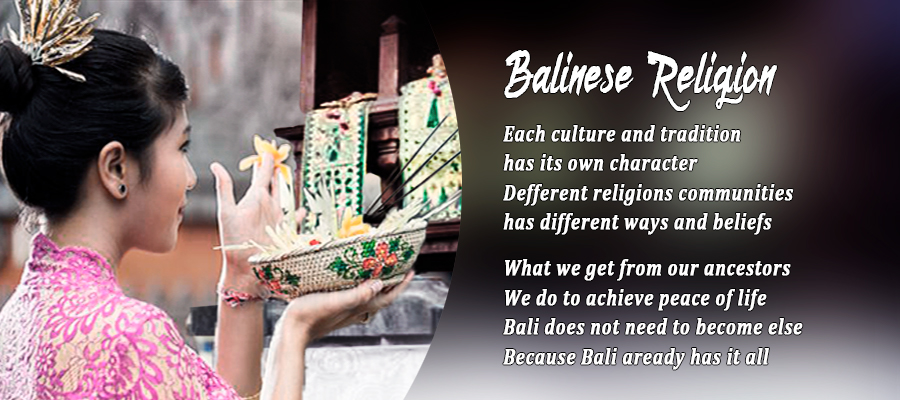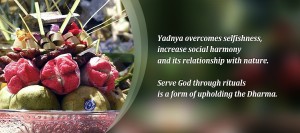The basic principle of Balinese religion is that the highest belief of “Ida Sanghyang Widhi Wasa” (God Almighty) and has been passed down to people with holy beliefs. Thus the Balinese seem to devote most of their time to a series of worship, attaining enlightenment, purification, performing yadnya processions, and ceremonies in sustainable shrines that have been passed down for generations.
The Balinese call their religion Agama Tirta (“Science of the Holy Water“), which is also an interpretation and unification of culture and teachings from Java, India and China. Agama Tirta much closer to nature.
The Balinese believe that the deity is a sacred ray from God and also symbols of forces. Particularly importance to Balinese Hindu are the God of Siva. Brahma and Wisnu is also another important Hindu god. The Balinese traditionally believe that their Ancestors are Bhatara, a small spark from God. Each family line, said the Balinese, has a different ancestor worship, which is why there are so many temples in their homes. Generations of marriage between families who worship different ancestors have created a unique belief for each family, each Bhatara and ancestor is presented with offerings that add more emphasis on duties and obligations in life.
Balinese Hinduism
Hinduism (Veda) arrives relatively late to Bali and is superimposed on a traditional belief system that is very strong and will not be easily moved. Hindu Bali is a fusion of Hindu Vedas, traditional Javanese and Balinese beliefs.
This includes the animist elements of ancestor worship, drawing some differences between secular, religious and supernatural life; and make no real difference between the living and the dead.
Contrary to the general belief that Hinduism is not a monotheistic belief, all Hindus worship one God – the Stump. The Deva’s are manifestations of God. This manifestation is determined by social position and condition and geographical location. Balinese not only believe that gods live in volcanoes and heaven, but they feel and believe their gods are everywhere and anytime.
Hinduism practiced in Bali has been described as the Trinity (Tri Murti) of Shiva, Vishnu and Brahma. Shivaism in general is the most powerful in Bali. The incarnations of Vishnu, Krishna and Rama and the traditional Ramayana story also have a high place in Balinese Hinduism. Karma is the main basis of Balinese life.
Hinduism in Bali bears resemblance to religion as it is practiced in India as a religious teaching that was first brought to Bali from the 14th century Majapahit Kingdom of East Java, did not replace the strong religious beliefs that already existed and the existence of a supreme cultural life. In contrast, Hinduism is mixed with traditional traditions and beliefs such as animism and ancestor worship to form strong and unique faiths.
In Bali, religion is a very important part of daily life and people make daily offerings to the gods, Bhatara and Ancestors is their actively participate in various rituals event at the temple. Balinese Hindus also make offerings and perform temple rituals to pacify the negativity that they believe is personifying the destructive forces of nature. One the day before Nyepi, great offerings were given to the forces of evil at the crossroads of the village, where negative spirits were believed to roam. Before each ceremony, a cleansing ceremony must be held to ward off all negative and cleanse the place spiritually.
In Bali, Hinduism developed by itself. Hinduism is at least 3,000 years old and originates from the creation of the Vedas, compilation of prayers, hymns, and other religious writings. Hindus no have a single founder or prophet. There is only one God, although many different manifestations are named and classified in great detail.
Hindu epics are became famous form as the basis of sacred dance in Bali. The Balinese have their own trinity of the highest gods. Because of the caste system, many people were exiled in India. In Bali most still believe in the caste system; while the young have ignored it.
Balinese Animism
The Balinese believe that God is everywhere and that each member of the family’s spirits returns from generation to generation by reincarnation. Life is seen as a cycle that begins in a sacred state as a baby. When a person gets older, he moves away from this state of purity and returns to that state at the time of death.
The Balinese believe that the Mountain is the highest and the holiest of all places. The house is oriented towards the mountains and the bed is positioned so the head refers to it. People in Bali sleep with their heads pointing to the sacred mountain. Mount Agung in Bali in terms of being the most important place. Mount Agung is considered the abode of the gods. Buildings and villages have traditionally been oriented to it.
According to Balinese creation myths, seven Angels came down to earth using clothes like wings. While they were bathing, a prince stole one of the nymphs’ clothes and told her he would not return it until she gave birth to a child. The goddess gave up and gave birth to the first man, but said, “You might have this child for a short life on earth, but after that remember, he returned to me.” Even today mothers bring their crying children out and point to the stars, saying, “That’s where we all come from and where we all come back, and don’t need to cry.
Balinese Temples
Temples in Bali can be found easily everywhere which reflects their importance in the Balinese spiritual life. They are a place to communicate with great souls through offerings and prayers. Holy days and worship are times when the holy spirit comes down from the world of nature to inhabit the temples. The whole community will come to the temples then with offerings of fruit and flowers.
The temples in Bali are very special as centers of spiritual communication with Hindu gods, they also carry out complex dating systems through their ritual calendars.
Each village has at least three main temples called Tri Khayangan; Pura Desa, Pura Puseh and Pura Dalem.
Families respect their ancestors in the family temple. Another family temples such as Panti or Kawitan and Sad Kahyangan. The biggest is the Besakih Temple located on the slopes of the Gunung Agung considered to be the most sacred by all Balinese.
Each temple has at least have one six-monthly event or event in each year known as Odalan, often beyond that, there are so many more religious celebrations in Bali.
Religion, Culture and Balinese Daily Life
Religion, culture and tradition are woven into every aspect of daily life. Some anthropologists say Balinese do not have a secular culture. “From the Balinese point of view,” anthropologist John reader said, “the whole universe is an expression of enormous spiritual ability. Everything owes its existence to the power of the main spiritual power; everyone must at all times be aware of their debts. this power … its demands have produced a society where everyone knows their place in all the terms.
The Balinese make offerings every day. Usually a small lump of rice is placed on a banana leaf and placed around the house and family land. Flowers and fruits in a neatly folded palm leaf box are left on the ground to soothe negatif spirits. Temple offerings consist of flower pyramids and beautifully arranged foods.
On special days the women make their yadnya in the form of Canang and Sesajen, adding flowers and fruits in knitting from coconut leaves.
In addition to these daily offerings, rice and flowers are also presented at the shrine, on the side of the road on special days. On any given day there is a celebration at a temple somewhere and most make as many offerings as a form of devotion.





